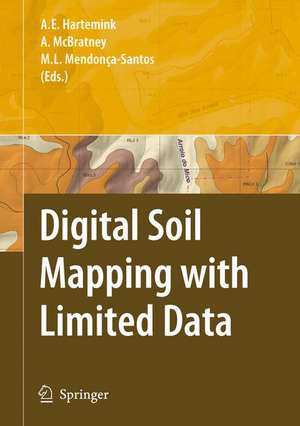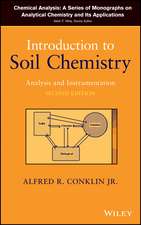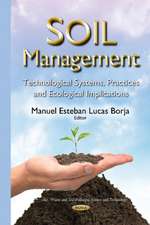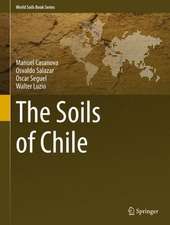Digital Soil Mapping with Limited Data
Editat de Alfred E. Hartemink Cuvânt înainte de Robert J. Ahrens Editat de Alex B. McBratney, Maria de Lourdes Mendonça-Santosen Limba Engleză Hardback – 12 aug 2008
| Toate formatele și edițiile | Preț | Express |
|---|---|---|
| Paperback (1) | 936.65 lei 6-8 săpt. | |
| SPRINGER NETHERLANDS – 19 oct 2010 | 936.65 lei 6-8 săpt. | |
| Hardback (1) | 945.33 lei 6-8 săpt. | |
| SPRINGER NETHERLANDS – 12 aug 2008 | 945.33 lei 6-8 săpt. |
Preț: 945.33 lei
Preț vechi: 1152.84 lei
-18% Nou
Puncte Express: 1418
Preț estimativ în valută:
180.91€ • 188.48$ • 150.42£
180.91€ • 188.48$ • 150.42£
Carte tipărită la comandă
Livrare economică 11-25 februarie 25
Preluare comenzi: 021 569.72.76
Specificații
ISBN-13: 9781402085918
ISBN-10: 1402085915
Pagini: 446
Ilustrații: XXIV, 446 p. 109 illus., 55 illus. in color.
Dimensiuni: 152 x 229 x 33 mm
Greutate: 0.91 kg
Ediția:2008
Editura: SPRINGER NETHERLANDS
Colecția Springer
Locul publicării:Dordrecht, Netherlands
ISBN-10: 1402085915
Pagini: 446
Ilustrații: XXIV, 446 p. 109 illus., 55 illus. in color.
Dimensiuni: 152 x 229 x 33 mm
Greutate: 0.91 kg
Ediția:2008
Editura: SPRINGER NETHERLANDS
Colecția Springer
Locul publicării:Dordrecht, Netherlands
Public țintă
ResearchCuprins
Digital Soil Mapping: A State of the Art.- Digital Soil Mapping Technologies for Countries with Sparse Data Infrastructures.- A New Global Demand for Digital Soil Information.- Development and Application of Digital Soil Mapping Within Traditional Soil Survey: What will it Grow Into?.- Soil Map Density and a Nation’s Wealth and Income.- Dealing with Limited Spatial Data Infrastructures.- Digital Soil Mapping as a Component of Data Renewal for Areas with Sparse Soil Data Infrastructures.- Challenges to Digital Soil Mapping.- Mapping Potassium Availability from Limited Soil Profile Data in Brazil.- GIS as a Support to Soil Mapping in Southern Brazil.- Experiences with Applied DSM: Protocol, Availability, Quality and Capacity Building.- Towards a Data Quality Management Framework for Digital Soil Mapping with Limited Data.- Demand-Driven Land Evaluation.- Digital Soil Mapping – Methodologies.- Diffuse Reflectance Spectroscopy as a Tool for Digital Soil Mapping.- Digital Soil Mapping at a National Scale: A Knowledge and GIS Based Approach to Improving Parent Material and Property Information.- 3D Modelling of Geology and Soils – A Case Study from the UK.- Landsat Spectral Data for Digital Soil Mapping.- From a Large to a Small Scale Soil Map: Top-Down Against Bottom-Up Approaches.- An Approach to Removing Uncertainties in Nominal Environmental Covariates and Soil Class Maps.- Digital Soil Mapping Using Logistic Regression on Terrain Parameters for Several Ecological Regions in Southern Brazil.- Purposive Sampling for Digital Soil Mapping for Areas with Limited Data.- Assessment of Land Degradation Using NASA GIMMS: A Case Study in Kenya.- Digital Soil Mapping – Examples.- Spatial-Temporal Changes in Land Cover, Soil Properties and Carbon Stocks in Rio de Janeiro.-Broad-Scale Soil Monitoring Through a Nationwide Soil-Testing Database.- Online Soil Information Systems – Recent Australian Experience.- Digital Soil Mapping Using Legacy Data in the Eden Valley, UK.- Delineating Acidified Soils in the Jizera Mountains Region Using Fuzzy Classification.- Incorporating Legacy Soil pH Databases into Digital Soil Maps.- The Digital Terrain Model as a Tool for Improved Delineation of Alluvial Soils.- Building a Digital Soil Data Base of the Solimões River Region in the Brazilian Central Amazon.- Enhancing the Use of Remotely-Sensed Data and Information for Digital Soilscape Mapping.- The Use of GIS and Digital Elevation Model in Digital Soil Mapping – A Case Study from São Paulo, Brazil.- Geomorphometric Attributes Applied to Soil-Landscapes Supervised Classification of Mountainous Tropical Areas in Brazil: A Case Study.- Digital Soil Mapping of Soil Properties in Honduras Using Readily Available Biophysical Datasets and Gaussian Processes.- Digital Mapping of Soil Classes in Rio de Janeiro State, Brazil: Data, Modelling and Prediction.- Priorities in Digital Soil Mapping.- Synthesis and Priorities for Future Work in Digital Soil Mapping.
Textul de pe ultima copertă
There has been considerable expansion in the use of digital soil mapping technologies and development of methodologies that improve digital soil mapping at all scales and levels of resolution. These developments have occurred in all parts of the world in the past few years and also in countries where it was previously absent. There is almost always a shortage of data in soil research and its applications and this may lead to unsupported statements, poor statistics, misrepresentations and ultimately bad resource management. In digital soil mapping, maximum use is made of sparse data and this book contains useful examples of how this can be done.
This book focuses on digital soil mapping methodologies and applications for areas where data are limited, and has the following sections (i) introductory papers, (ii) dealing with limited spatial data infrastructures, (iii) methodology development, and (iv) examples of digital soil mapping in various parts of the globe (including USA, Brazil, UK, France, Czech Republic, Honduras, Kenya, Australia). The final chapter summarises priorities for digital soil mapping.
This book focuses on digital soil mapping methodologies and applications for areas where data are limited, and has the following sections (i) introductory papers, (ii) dealing with limited spatial data infrastructures, (iii) methodology development, and (iv) examples of digital soil mapping in various parts of the globe (including USA, Brazil, UK, France, Czech Republic, Honduras, Kenya, Australia). The final chapter summarises priorities for digital soil mapping.
Caracteristici
Digital soil mapping (DSM) is an emerging and expanding topic in soil science There is a growing interest from neighbouring disciplines The book presents the latest technologies, challenges and ideas related to DSM 35 chapters range from overviews of the DSM technology in general to specific applications in areas without much soil information or areas where specific parameters are investigated









